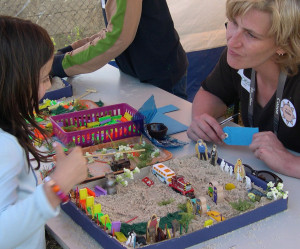July 9, 2009 at 12:45 pm
The other day I went to a local community workshop in my small rural village. The topic is not important for my purposes and it’s not my intention to embarrass anyone.
Rather I want to make a point: there’s more to community workshops than a conversation at tables, participants scribbling down a few ideas and facilitators writing down a few points on some large sheets of paper.
Going over old ground
In our local workshop, a group of community members and some professional advisors sat around for three hours going over old ground.
I thought: what if the consultants had summarised all that “old ground” (previous plans and policies) and given us an updated summary to work from.
“Nobody else complained”
Subsequent conversations with one of the facilitators yielded the comment that “nobody else complained.” Omigod! How often do we hear that in community engagement? Yet we well know that “not complaining” does not equate with “satisfaction”.
That conversation reminded me of another local conversation a couple of months ago, this time with a municipal officer in my own local council, who said that their “peer review” of their draft community engagement policy had confirmed that “children and young people are not our customers.”
I had smoke coming out of my ears after THAT conversation.
(re)visioning Footscray
That got me thinking about my friend, co-author and colleague, Andrea Cook of Red Road Consulting in Melbourne (see: www.redroad.com.au). Andrea went over old ground, all right, for the (re)visioning of Footscray in Maribyrnong, Melbourne in 2004.
See: https://www.maribyrnong.vic.gov.au/Files/Final_Executive_Summary_Revisioning_Footscray.pdf
We called the Footscray planning and community engagement process “(re)visioning” for a particular reason.
The participants at the Footscray stakeholders’ workshop in 2004 were gobsmacked by the amount of tedious and thorough background work Andrea had done before she met with them.
“We are not going over old ground,” she exclaimed. With a hundred local people, I sat patiently through a good hour of detailed PowerPoint summary of over a dozen planning publications.
Everyone was completely satisfied that the consultants were up-to-date.
Then we moved on. With everyone satisfied that their earlier contributions had been acknowledged.
Here’s the PowerPoint presentation Andrea used in the workshop: Footscray Vision Consolidation Presentation 27-08-04
So many ways”¦
I am not proposing a “one-size-fits-all” solution to this borning workshop problem. There are so many ways to run an effective workshop, even a small, humble one. It need not be complex.
Prioritise your issues!
At one point, we were asked in the workshop to “prioritise our issues”. We had lists – each of us – that were jumbles of issues, concerns, policies, initiatives”¦ and we were asked to collectively prioritise them.
How hard was that?
Actually, quite hard. We had no tools, no props, no help”¦ Our attempts were unsystematic, apples sorted with pears, hierarchies ignored”¦ a real mess”¦ No weighting, no real content analysis was possible”¦
A sticky wall or some sticky dots would get us out of this sticky situation
I kept thinking that a few sticky dots – or better still, some Post-its and a sticky wall – would have made the whole thing a dream. They are not an expensive option. You can buy sticky walls as a kit online from leading Australian community engagement consultants.
See: www.twyfords.com.au/twyfords/Twyfords-our-store.html
Using some props would have made it much more fun, less frustrating, less boring, and much easier for the consultants to analyse the outcomes. And to analyse them using our community weightings and categories – without the intervening bias of the researchers.
Why don’t we use these simple tools?
Why don’t we use these simple tools, these practical props? They are not expensive, they require no “equipment” (or not much, anyway) and they are so much more fun that endless, formless, unsophisticated brainstorming and discussion sessions.
I’d be interested to hear your responses.
Visioning or brainstorming?
My other concern with my local workshop was that we were supposed to be “visioning” but hardly a “visionary” or creative word was heard.
I’ve written two chapters on community visioning in my forthcoming book, Creative Community Planning (with Dianna Hurford and Christine Wenman). It was helpful (if dispiriting) to be reminded that this sort of non-visionary “visioning” still occurs. This is a big topic on which I will write more later.
So I need to ask, where are our “facilitators” getting their training? Who is helping them learn about what’s available?
Asking two simple questions:
I’d ask: Can these practitioners be encouraged to act out of real care for communities? Real care might be asking two simple questions:
“What’s the very best we can do here in this community?”
and
“How can we give something back to this community?”
There’s so much help out there to guide facilitators. So many hundreds of published and online manuals of methods and techniques. So many simple and creative tools that communities love.
“Oh dear, here come the butcher’s paper and the felt pens.”
It used to be said, “Uh, oh, here come the plans!” about community engagement.
Now, it’s, “Oh dear, here come the butcher’s paper and the felt pens.”
There has got to be more to community engagement – and visioning – than that!

Please send me a power point presentation of this wonderful material on best practices in community engagement skills
Dear Hassan:
Let me know exactly what you are after and I can send it to you.
Kind regards,
Wendy